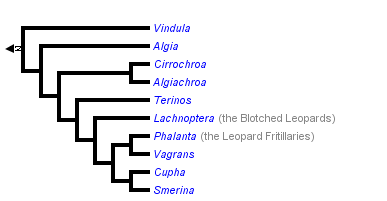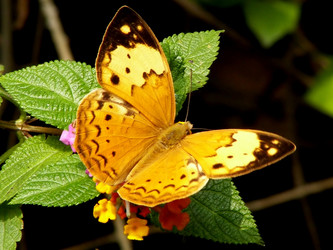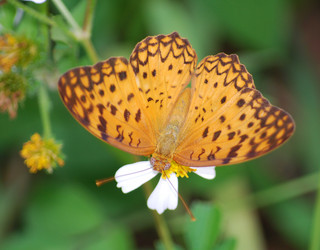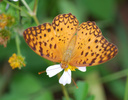Vagrantini
Niklas Wahlberg and Andrew V. Z. Brower


This tree diagram shows the relationships between several groups of organisms.
The root of the current tree connects the organisms featured in this tree to their containing group and the rest of the Tree of Life. The basal branching point in the tree represents the ancestor of the other groups in the tree. This ancestor diversified over time into several descendent subgroups, which are represented as internal nodes and terminal taxa to the right.

You can click on the root to travel down the Tree of Life all the way to the root of all Life, and you can click on the names of descendent subgroups to travel up the Tree of Life all the way to individual species.
For more information on ToL tree formatting, please see Interpreting the Tree or Classification. To learn more about phylogenetic trees, please visit our Phylogenetic Biology pages.
close boxIntroduction
A group of mainly southeast Asian and Australasian genera that may be paraphyletic with respect to Argynnini.
Discussion of Phylogenetic Relationships
The hypothesis presented here is that of Penz and Peggie (2003), with the position of Algiachroa inferred on the basis of discussion in Parsons (1999). The monophyly and relationships within this group are still not strongly corroborated - molecular data suggest that the pattern of affinities may be somewhat different from those presented here (Wahlberg and Brower, unpubl.).
References
Parsons M. 1999. The butterflies of Papua New Guinea: their systematics and biology. Academic Press, San Diego.
Penz CM, and Peggie D. 2003. Phylogenetic relationships among Heliconiinae genera based on morphology (Lepidoptera: Nymphalidae). Syst. Ent. 28: 451-479.
Title Illustrations

| Scientific Name | Cupha erymanthis |
|---|---|
| Location | Hong Kong |
| Specimen Condition | Live Specimen |
| Source | Spring Coming.... |
| Source Collection | Flickr |
| Image Use |
 This media file is licensed under the Creative Commons Attribution-ShareAlike License - Version 2.0. This media file is licensed under the Creative Commons Attribution-ShareAlike License - Version 2.0.
|
| Copyright | © 2007 Charles Lam |
| Scientific Name | Phalanta phalantha |
|---|---|
| Specimen Condition | Live Specimen |
| Source | 紅擬豹斑蝶 Phalanta phalaata |
| Source Collection | Flickr |
| Image Use |
 This media file is licensed under the Creative Commons Attribution-NonCommercial-ShareAlike License - Version 2.0. This media file is licensed under the Creative Commons Attribution-NonCommercial-ShareAlike License - Version 2.0.
|
| Copyright | © 2007 Changhua Coast Conservation Action 台灣水鳥研究 |
About This Page
Niklas Wahlberg

University of Turku, Finland

Middle Tennessee State University, Murfreesboro, Tennessee, USA
Correspondence regarding this page should be directed to Niklas Wahlberg at and Andrew V. Z. Brower at
Page copyright © 2006 Niklas Wahlberg and
 Page: Tree of Life
Vagrantini .
Authored by
Niklas Wahlberg and Andrew V. Z. Brower.
The TEXT of this page is licensed under the
Creative Commons Attribution License - Version 3.0. Note that images and other media
featured on this page are each governed by their own license, and they may or may not be available
for reuse. Click on an image or a media link to access the media data window, which provides the
relevant licensing information. For the general terms and conditions of ToL material reuse and
redistribution, please see the Tree of Life Copyright
Policies.
Page: Tree of Life
Vagrantini .
Authored by
Niklas Wahlberg and Andrew V. Z. Brower.
The TEXT of this page is licensed under the
Creative Commons Attribution License - Version 3.0. Note that images and other media
featured on this page are each governed by their own license, and they may or may not be available
for reuse. Click on an image or a media link to access the media data window, which provides the
relevant licensing information. For the general terms and conditions of ToL material reuse and
redistribution, please see the Tree of Life Copyright
Policies.
- First online 25 September 2006
- Content changed 11 November 2006
Citing this page:
Wahlberg, Niklas and Andrew V. Z. Brower. 2006. Vagrantini . Version 11 November 2006 (under construction). http://tolweb.org/Vagrantini/70207/2006.11.11 in The Tree of Life Web Project, http://tolweb.org/









 Go to quick links
Go to quick search
Go to navigation for this section of the ToL site
Go to detailed links for the ToL site
Go to quick links
Go to quick search
Go to navigation for this section of the ToL site
Go to detailed links for the ToL site